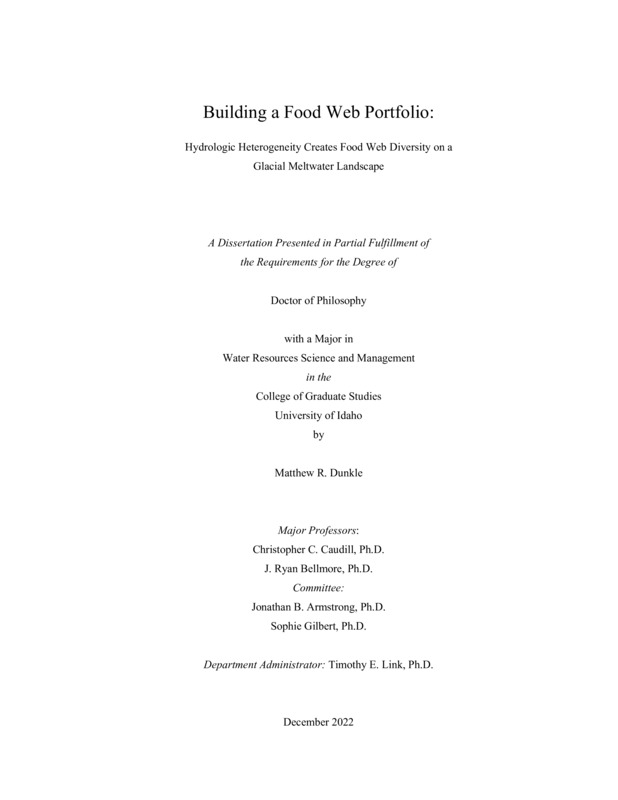Building a Food Web Portfolio: Hydrologic Heterogeneity Creates Food Web Diversity on a Glacial Meltwater Landscape
Dunkle, Matthew R. . (2022-12). Building a Food Web Portfolio: Hydrologic Heterogeneity Creates Food Web Diversity on a Glacial Meltwater Landscape. Theses and Dissertations Collection, University of Idaho Library Digital Collections. https://www.lib.uidaho.edu/digital/etd/items/dunkle_idaho_0089e_12475.html
- Title:
- Building a Food Web Portfolio: Hydrologic Heterogeneity Creates Food Web Diversity on a Glacial Meltwater Landscape
- Author:
- Dunkle, Matthew R.
- ORCID:
- 0000-0003-2147-3993
- Date:
- 2022-12
- Keywords:
- Alaska Community Assembly Food Webs Glacial Rivers Macroinvertebrate Salmon
- Program:
- Water Resources
- Subject Category:
- Ecology; Water resources management; Biology
- Abstract:
-
Meltwater streams fed by glaciers, icefields, and snow frequently have flow, temperature, and biogeochemical regimes distinct from non-meltwater streams. This physicochemical heterogeneity may support a diversity of freshwater food webs in landscapes where meltwater and non-meltwater streams currently co-occur. Additionally, these streams exist along a continuum which may serve as a space-for-time proxy for changes to physicochemical conditions as glacial and snowmelt influence diminishes with climate change. However, there remains a paucity of knowledge about how food webs are assembled on these rapidly changing landscapes. In the following pages, I describe three studies which examine how the structure of food webs supporting Pacific salmon vary between four streams in coastal southeast Alaska: glacier-fed, snow-fed, rain-fed, and one fed by a combination of rain, snow and glacial-melt. I first assess the temporal dynamics and synchrony of abiotic patterns and biomass waves of the trophic base of the food web. I then analyze the community structure and secondary production dynamics of the aquatic invertebrate community at an annual scale. Lastly, I present quantitative flow food web models using trophic-basis-of-production approach to illuminate the pathways of energy flow that support juvenile salmon. Using these approaches, I found that these cryospheric streams vary greatly in the biophysical patterns and community diversity and structuring. These differences, in turn, create distinct trophic pathways that support fish production between stream types with few shared links between and a greater number of resource flows supporting Coho and Dolly Varden in glacial- and snowmelt streams and substantial overlap in rainwater and combined-signature sites. Although glacial meltwater streams may be less productive overall, they support fish via distinct and diverse pathways from non-meltwater streams and contribute to landscape variation and prey community beta diversity is theorized to increase food resilience and stability. This may be especially true for mobile consumers like juvenile salmon which may track different growth opportunities and energy flow pathways across spatially structured food webs. As glacial and snowmelt contributions to surface waters decline, these distinct meltwater food webs are at risk of extirpation, which could leave salmon populations vulnerable to disturbance and may simplify the overall community structure on the landscape.
- Description:
- doctoral, Ph.D., Water Resources -- University of Idaho - College of Graduate Studies, 2022-12
- Major Professor:
- Caudill, Christopher C.; Bellmore, J. Ryan
- Committee:
- Gilbert, Sophie L.; Armstrong, Jonathan B.; Link, Timothy
- Defense Date:
- 2022-12
- Identifier:
- Dunkle_idaho_0089E_12475
- Type:
- Text
- Format Original:
- Format:
- application/pdf
- Rights:
- In Copyright - Educational Use Permitted. For more information, please contact University of Idaho Library Special Collections and Archives Department at libspec@uidaho.edu.
- Standardized Rights:
- http://rightsstatements.org/vocab/InC-EDU/1.0/

